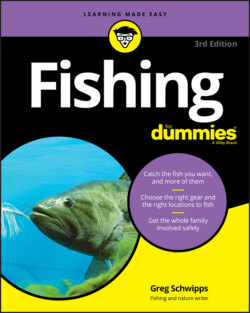Читать книгу Fishing For Dummies - Greg Schwipps - Страница 36
Wear layers and always be happy
ОглавлениеYou don’t need to dress better, you need to dress smarter. Wearing layers is the key to adapting to changing weather conditions while fishing. Even on a calm, sunny day, you face big temperature swings on a typical fishing trip. When you start out, possibly before dawn, the day begins dark, chilly, and damp. Four hours later, you find yourself under a blazing sun cooking you with 95 degrees of oven-blast heat.
Of course, the weather can change beyond the normal progression of the sun, as well. Storms blow in, rain starts and stops. Winds pick up and die down. One outfit won’t match all of these ever-changing conditions. Even with the latest clothing technology, which really is quite amazing, you need to dress in layers to be comfortable all day or night when fishing.
The basic setup in the following list will serve you in most places, most of the time. Modify it when it’s ultra-hot, like in the tropics with no chance of anything remotely cool happening or, at the opposite end of the weather spectrum, when it’s cold and going to stay that way, such as Lake Michigan in November. Outside of those extremes, follow this list and you’ll be prepared for weather from about 40 degrees F to 90 degrees F, which is the range at which most of us fish:
Against your skin: Start with a regular old cotton t-shirt and shorts or pants in all but the coolest or hottest weather. If it’s going to be really hot, go with a lighter, more breathable nylon/polyester-blend shirt. If it’s going to be really cold, put on your baselayer first.
Baselayer: In cold weather, a baselayer made from merino wool, nylon, polyester, spandex, or fleece will amaze you with its comfort, thinness, and warmth. Baselayers should be worn right against the skin.
Shorts (with pockets): Even if you choose not to wear them while fishing, throw a pair in your car for the ride home.
Pants, jeans, khakis: If you don’t like cotton, wear something made of a synthetic material like nylon, spandex, polyester or fleece. These materials often have a sun-blocking rating of 50 UPF (ultraviolet protection factor) or so, and can also be stain-resistant. Make sure your fishing pants have plenty of accessible pockets.
Long-sleeve shirt: Even when it’s hot, it’s a good idea to always wear a long-sleeve shirt to keep the sun off. Most of you know that prolonged exposure to the sun is dangerous for unprotected skin. And fishing is a pastime that gives you about as much sun as any human activity. Modern shirts have sun-blocking capabilities built right into the fabric, and advertise the UPF on the label.
Fleece pullover: There are a lot of brand names for that soft, fleecy synthetic material. All are warm, lightweight, and comfortable.
Rain gear: Get the best rain gear (a set with pants and a jacket) that you can afford and bring it along if there’s even a slight chance of rain. (Keep it in your foul-weather bag, which I will cover next.) I always have rain gear along when I'm on a boat, not just for rain, but also to break the wind when moving from one fishing spot to another. Get a rain jacket that fits over your life jacket or fishing vest. Waist-high is the best length for wading anglers. You can often get pants or a bib in your rain gear set, and bibs are often the better choice for boating anglers, because they stay in place better while frequently sitting and standing. If you forget your rain jacket, you can make a poncho out of a lawn-size garbage bag, so it’s a good idea to keep a couple in your gym bag or trunk as well. Cut holes for the head and arms and, in a pinch, you’re in business. Now, you’ll look a little funny, but you’ll be dry.
